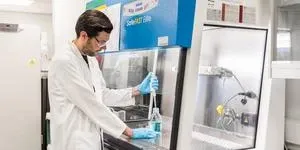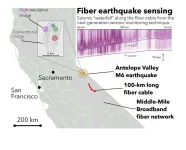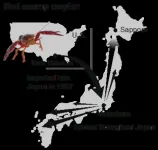(Press-News.org) Maillard reaction locks away 4 million tonnes of organic carbon a year
Process helped stabilise conditions for complex life to evolve
A chemical process used in the browning of food to give it its distinct smell and taste is probably happening deep in the oceans, where it helped create the conditions necessary for life.
Known as the Maillard reaction after the French scientist who discovered it, the process converts small molecules of organic carbon into bigger molecules known as polymers. In the kitchen, it is used to create flavours and aromas out of sugars.
But a research team led by Professor Caroline Peacock at the University of Leeds argues that on the sea floor, the process has had a more fundamental effect, where it has helped to raise oxygen and reduce carbon dioxide levels in the atmosphere, to create the conditions for complex life forms to emerge and thrive on Earth.
Source of organic carbon
Organic carbon in the oceans mostly comes from microscopic living organisms. When those organisms die, they sink to the sea floor and are consumed by bacteria. That decay process uses oxygen and releases carbon dioxide into the ocean which eventually ends up in the atmosphere.
As a result of the Maillard reaction, the smaller molecules are converted into larger molecules. Those larger molecules are harder for microorganisms to breakdown and remain stored in the sediment for tens of thousands - if not millions - of years.
The scientists describe this as the “preservation of organic carbon”.
That long-term storage or preservation of organic carbon on the seabed had major consequences for conditions that developed on the surface of the Earth. It limited the release of carbon dioxide, allowing more oxygen to reach the Earth’s atmosphere and limited variation in the warming of the Earth’s land surface over the last 400 million years to an average of about five degrees Celsius.
‘Too slow to have any impact’
Dr Oliver Moore, first author in the study and a Research Fellow in Biogeochemistry in the School of Earth and Environment at Leeds, said: “It had been suggested back in the 1970’s that the Maillard reaction might occur in marine sediments, but the process was thought to be too slow to impact the conditions that exist on Earth.
“Our experiments have shown that in the presence of key elements, namely iron and manganese which are found in sea water, the rate of reaction is increased by tens of times.
“Over Earth’s long history, this may have helped create the conditions necessary for complex life to inhabit the Earth.”
As part of the study, the scientists modelled how much organic carbon has been locked into the seabed because of the Maillard reaction. They estimate it has resulted in around 4 million tonnes of organic carbon each year being locked into the seabed. That is the equivalent weight of around 50 London Tower Bridges.
To test their theory, the researchers looked at what happened to simple organic compounds when mixed with different forms of iron and manganese in the laboratory at 10 degrees Celsius, the temperature of the seabed.
Analysis revealed that the “chemical fingerprint” of the laboratory samples - which had undergone the Maillard reaction - matched those from sediment samples taken from seabed locations around the world.
That “fingerprint” analysis was conducted at the Diamond Light Source in Oxfordshire, the UK’s synchrotron which generates intense beams of light energy to reveal the atomic structure of samples.
Dr Burkhard Kaulich, Principal Beamline Scientist of the Scanning X-ray Microscopy beamline (I08-SXM) at Diamond Light Source, said: “Our advanced I08-SXM instrumentation with its high stability, energy and optical resolution was developed and optimised to help probe carbon chemistry and reactions which take place in environmental systems.
“We are very proud to have been able to contribute to a better understanding of the fundamental chemical processes involved in the creation of complex life forms and climate on Earth.”
Professor Peacock, from Leeds, said: “It’s immensely exciting to discover that reactive minerals such as those made from iron and manganese within the ocean have been instrumental in creating the stable conditions necessary for life to have evolved on Earth.”
The lessons learned from a better understanding of the Earth’s geochemical processes could be used to harness new approaches to tackling modern-day climate change.
Dr James Bradley, an environmental scientist at Queen Mary University of London and one of the authors of the paper, said: “Understanding the complex processes affecting the fate of organic carbon that is deposited on the seafloor is crucial to pinpointing how Earth’s climate changes in response to both natural processes and human activity, and helping humanity better manage climate change, since the application and long-term success of carbon capture technologies relies on carbon being locked away in stable forms rather than being transformed into carbon dioxide.”
The study, “Long-term organic carbon preservation enhanced by iron and manganese”, is published today (Wednesday, Aug 2) in the scientific journal Nature and can be downloaded from the link when the embargo lifts: https://www.nature.com/articles/s41586-023-06325-9
Note to Editors
Please contact David Lewis in the press office at the University of Leeds - d.lewis@leeds.ac.uk or pressoffice@leeds.ac.uk - with any requests to talk to the researchers or for more information.
When the embargo lifts, the paper can be downloaded from the Nature website by clicking on the link: https://www.nature.com/articles/s41586-023-06325-9
The doi of the publication is: 10.1038/s41586-023-06325-9
END
Nature’s kitchen – how a chemical reaction used by cooks helped create life on Earth
2023-08-02
ELSE PRESS RELEASES FROM THIS DATE:
Genetic variant linked to lower levels of HIV virus in people of African ancestry
2023-08-02
An international team of researchers has found a genetic variant that may explain why some people of African ancestry have naturally lower viral loads of HIV, reducing their risk of transmitting the virus and slowing progress of their own illness.
Reported today in Nature, this is the first new genetic variant related to HIV infection discovered in nearly 30 years of research. It could, in the future, help direct the development of new treatments approaches for those living with HIV.
HIV remains a major threat to global health. According to UNAIDS, there were 38.4 million people living with HIV globally in 2021. A combination of pre-exposure drugs and medicines that dramatically ...
An ancient grain unlocks genetic secrets for making bread wheat more resilient
2023-08-02
Building on the Middle East’s reputation as one of the historical birthplaces of cereal crop domestication, a KAUST-led team has compiled the first complete genome map of an ancient grain known as einkorn[1].
The 5.2-billion-letter-long sequence provides a window into the evolutionary origins of different wheat species. It could help farmers and crop breeders to develop bread wheat varieties with enhanced disease resistance, higher yields and improved hardiness.
“By understanding the genetic diversity and evolutionary history of einkorn, researchers can now leverage its potential for future ...
Perinatal depression screening among sexual minority women
2023-08-02
About The Study: The findings of this study suggest that, although sexual minority women are at high risk of postpartum depression, their sexual identities are largely undocumented in medical records, highlighting the need for strategies to measure sexual orientation that can reliably capture this information.
Authors: Leiszle Lapping-Carr, Ph.D., of the Northwestern University Feinberg School of Medicine in Chicago, is the corresponding author.
To access the embargoed study: Visit our For The Media website at ...
Comparative risks of potential adverse events following COVID-19 mRNA vaccination among older adults
2023-08-02
About The Study: In this study of 6.3 million older U.S. adults, the mRNA-1273 (Moderna) vaccine was associated with a slightly lower risk of several adverse events compared with BNT162b2 (Pfizer-BioNTech), possibly due to greater protection against COVID-19. Future research should seek to formally disentangle differences in vaccine safety and effectiveness and consider the role of frailty in assessments of COVID-19 vaccine performance.
Authors: Daniel A. Harris, Ph.D., of the Brown University School of Public Health in Providence, Rhode Island, is the corresponding ...
Moderna is safest, most effective mRNA vaccine against COVID-19 for older adults, study shows
2023-08-02
PROVIDENCE, R.I. [Brown University] — While mRNA vaccines against COVID-19 have been found to be safe and effective for the general population, in-depth evidence about safety and effectiveness for older adults and individuals with chronic health conditions is more limited.
To address that gap, a team led by Brown University researchers conducted the largest head-to-head comparison study of the two mRNA vaccines approved by the U.S. Food and Drug Administration — the Moderna and Pfizer-BioNTech vaccines. The results, published in JAMA Network Open, ...
Fiber optic cables detect and characterize earthquakes
2023-08-02
In California, thousands of miles of fiber optic cables crisscross the state, providing people with internet. But these underground cables can also have a surprising secondary function: they can sense and measure earthquakes. In a new study at Caltech, scientists report using a section of fiber optic cable to measure intricate details of a magnitude 6 earthquake, pinpointing the time and location of four individual asperities, the "stuck" areas of the fault, that led to the rupture.
For several years, Professor of Geophysics Zhongwen Zhan (PhD '14) ...
Potential neuropathic pain treatment shows promise in preclinical tests
2023-08-02
A non-opioid designer molecule for treating chronic neuropathic pain by calming hyperactive pain-sensing neurons in the peripheral nervous system has had promising results in a preclinical study conducted by researchers at Weill Cornell Medicine and the Burke Neurological Institute.
In the study, published Aug. 2 in the British Journal of Anaesthesia, the first-in-class drug conceptualized by lead author Dr. Gareth Tibbs was found to function according to its design at both the molecular level and as an apparently side-effect-free pain reliever in rats.
“With either a single dose or seven days of daily dosing, we saw a significant reversal of neuropathic pain signs in the ...
Learning how to control HIV from African genomes
2023-08-02
“We searched for human genetic variation that associates with spontaneous control of HIV and identified a novel region in the genome that is only variable in populations of African ancestries,” says Professor Jacques Fellay at EPFL’s School of Life Sciences. “We used a combination of computational and experimental approaches to explore the biological mechanism behind the genetic association and provide evidence that the gene CHD1L acts to limit HIV replication in a subset of white blood cells.”
HIV is still a problem
Despite significant advances in treatment and access to therapy, the ...
How the tropical red swamp crayfish successfully invaded the cold regions of Japan
2023-08-02
Owing to human activities and climate change, many animal species have invaded new habitats. Such biological invasion comes with devastating impacts on the local biodiversity and ecosystems. The red swamp crayfish—known to the scientific world as Procambarus clarkii (P. clarkii)— is no exception. P. clarkii is a freshwater crayfish native to the tropical regions of southern USA and northeastern Mexico. After their introduction to different parts of the world, they have become one of the most widespread and invasive animal species. They are known for their adaptability and aggressive behavior that ensure their survival in a wide range of environments, ...
Breast cancer patients with higher BMI more likely to experience heart damage during chemotherapy
2023-08-02
Breast cancer survival rates have improved considerably in the last few decades in Colombia, but factors that increase the likelihood of patients experiencing cardiovascular side effects, like cardiotoxicity, are not well-known or well-treated. A recent study in the North-East region of Colombia found 11.94% of patients with a high BMI being treated for breast cancer at a regional center experienced heart damage, or cardiotoxicity, during chemotherapy. The study will be presented at the American College of Cardiology (ACC) Latin America 2023 Together with Asociación Costarricense ...




